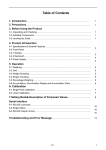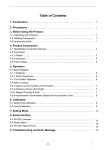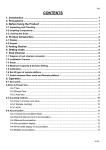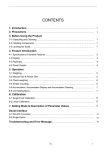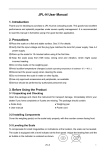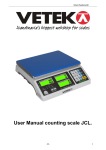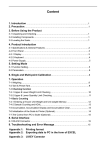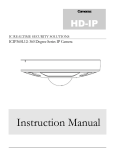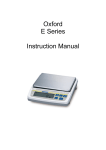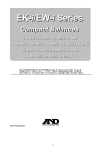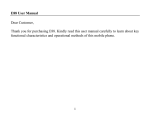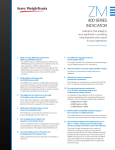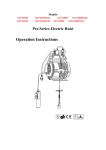Download Table of Contents
Transcript
Table of Contents 1. Introduction………………………………….…………………………………….............. 1 2. Precautions……………………………………….………………………………………… 1 3. Before Using the Product 3-1 Unpacking and Checking…………………………………………………………………….. 1 3-2 Installing Components.………………………………………..…………………………. …. 1 3-3 Leveling the Scale………………………………………………..………………………….. 2 4. Product Introduction 4-1 Specifications & General Features …………………………………………………………. 4-2 Front Panel 4-2-1 Display …….………………………………………………………………………………... 4-2-2 Keyboard………………………………………………………………………………........ 4-3 Power Supply……………………………………………………………………………........ 3 3 4 5 5. Operation 5-1 Basic Weighing 5-1-1 Weighing……………………………………………………………………………………. 5-1-2 Tare & Preset Tare…………………………………………………………………………. 5-1-3 Unit Switch Operation …………………………………………….................................. 5-2 Basic Counting 5-2-1 Entering a Known Unit Weight …………….………………………............................... 5-2-2 Sample Counting & ACAI …….………..………………………………………………… 6 6 7 7 7 6. Calibration 6-1 Single Point Calibration ……………………………………………………………………… 8 6-2 Linear Calibration…………………………………………………………………………….. 9 7. Setting Mode……………………………………………………………………………….. 10 8. Serial Interface 8-1 RS-232 Connector……………………………………………………………………………. 11 8-2 Single Option…………………………………………………………………………………. 12 8-3 RS-232 Output Format………………………………………………………………………. 12 9. Troubleshooting and Error Message……………………………………………… 13 LGCN 0 1. Introduction This manual contains installation, operation and maintenance instructions for the LGCN Series counting scale. Please read the manual completely before installation and operation . 2. Precautions ◎ P lace the scale on a flat and stable surface( Refer to Section 3-3). ◎ V erify that the input voltage and the plug type m atches the localAC power supply(Refer to Section 4-3). ◎ Make sure power cord does not pose a potential obstacle or tripping hazard . ◎ Keep the scale away from EMI noise, strong wind and vibration which might cause incorrect reading. ◎ Avoid sudden temperature change (suitable operating temperature is between -5℃~ 40℃.) ◎ Do not drop loads on the platform. ◎ D isconnectthe pow er supply while cleaning the scale. ◎ Do not immerse the scale in water or other liquids. ◎ S ervice should be perform ed by authorized personnelonly. 3. Before Using the Product 3-1 Unpacking and Checking Open the package and check the instrument for transport damage. Immediately inform your dealer if you have complaints or if parts are missing. Model LGCN-3075 contains : ● Sc ale body ● User manual ● Weighing platform(plastic base with stainless steel pan) ● Wire (power cord) ● Wind Shield Model LGCN-1530,LGCN-7515 contains: ● Sc ale body ● User manual ● Stainless steel pan ● Power cord ● Three-hole aluminum column ● Allen wrench ● Two M5 Allen screw 3-2 Installing Components A. Models LGCN-1530, LGCN-7515 1. Before using the scale, rotate counterclockwise to remove the delivery protection screw--- [1] . LGCN 1 2. Align the three-hole aluminum column [5], center of the three round holes on the scale support [4] with the corresponding inside holes on the “-”shaped iron piece [6]. Then fix the three-hole aluminum column [5] and scale support [4] on the “-”shaped iron piece of the scale by tightening the M5 Allen screws[3] using an Allen wrench; 3. Put the stainless steel weighing pan [2] on the scale support [4]. B. Model LGCN-3075 1. Before using the scale, rotate counterclockwise to remove the delivery protection screws--- [1] . 2. Remove the the delivery protection screw [2] ,then screw the weighing pan clockwise and downwards . C. Wind Shield installation Note: It is recommended that the delivery protection screws be re-installed after transporting the scale. Do not over-tighten the delivery protection screws as it may damage the load cell. 3-3 Leveling the Scale Adjust the leveling feet until the bubble is centered in the circle of the level indicator (located on the front panel). Note :Ensure that the scale is level each time its location is changed . LGCN 2 4.Product introduction 4-1 Specifications& General Features Specifications Model LGCN-3075 LGCN-1530 LGCN-7515 Capacity(g) 300 750 1500 3000 7500 15000 Division(g) 0.02 0.05 0.1 0.2 0.5 1 Pan Size (w×d)(in/mm) φ150 235×178 Scale Dimensions(w×d×h)(mm) 280×250×96 Display 3 backlit LCD Displays (5/5/5) Weighing Units g, Lb Option RS-232 output interface printer Power supply AC 110V/220V (AC±10%) or rechargeable battery (6V/4A) Operating Temperature 0℃~40℃ Humidity Range 10% to 85% humidity ,non-condensing General Features ◎ Three backlit LCDS ◎ Durable stainless steel weighing pan ,ABS housing and waterproof keypad ◎ 18 button operation with numeric keypad ◎ Pond or gram weighing units ◎ Auto unit weight re-computing ◎ Auto shut off for power saving ◎ Protection for overloading and transportation 4-2 Front Panel 4-2-1 Display 1. Weight Display Displays current weight on scale 2. Unit Weight Display Display the unit weight. LGCN 3 3. Total Count Display Display the current count of items on the scale . Low battery indication 4. 5. NET Indication for displaying net values 6. TARE When “TARE” indicator appears , the weight of the container is tared . 7. ZERO : when “ZERO” indicator appears, the scale is in zero status. 8. Charge Lamp Red--- battery is charging Green---battery is fully charged 9. First Range Capacity Lamp ON when the weight on the weighing pan is less than or equal the first range of capacity. 10. Second Range Capacity Lamp ON when the weight on the weighing pan is the first range of capacity. 11. g( gram ) Symbol “ ” pointing at g, indicating that the current weighing unit is gram. 12. kg (kilogram ) Symbol “ ” pointing at kg, Indicating that the current weighing unit is kilogram.【applicable for LGCN-7515 only】 13. SAMPLE INSUFFICIENT Symbol “ ” pointing at “SAMPLE INSUFFICIENT ” when unit weight is lower than 4/5 scale division or quantity of samples is less than 10 pieces . 4-2-2 Keyboard 1) 0 ~9 numeric keys Enters specific values for tare, unit weight and other data entries. LGCN 4 2) SMPL With samples on the weighing pan and inputs the indicated sample size to calculate piece weight. 3) Press down to turn the scale ON/OFF. 4) Inputs the indicated unit weight value entered via numeric keys. 5) 6) Zeros the display (within 2% of max.capacity) or cancels Tare action. CE 7) Clears the indicated input values. Inputs the weight of the object on the weighing pan as a Tare value. Inputs the indicated value entered via the numeric keys as a pre-set Tare value . Cancel tare action. 8) PRINT Sends data to RS232 port. 9) Decimal point. 4-3 Power Supply Please verify the local AC power source and switch the two-stage switch (110V/220V) to the proper place before plugging into the power outlet. Alternative Power Supply 1) AC 110V/220V (AC±10%) 2) (6V/4A) Internal Rechargeable Battery Power Consumption About 300mW, 80hrs (without backlight) About 380 mW, 65hrs (with backlight) Low Battery Warning When “ ” appears in the upper left corner of the weight window, the battery requires recharging. The charge lamp turns green from red when the recharging is completed (which takes about 8 hours).Disconnect the scale from power supply when it is fully charged. Note: Battery is replaced only by an authorized service dealer .Risk of explosion can occur if replaced with wrong types or connected improperly. LGCN 5 5. Operation 5-1 Basic Weighing 5-1-1 Weighing Begin with no load on the scale, the display reading zero . Place item(s) to be weighed on the scale. The display shown is 1000.0g, gross weight. 5-1-2 Tare & Preset Tare Tare When weighing a sample that must be held in a container, taring stores the container weight into memory. Under the weighing mode, place the container on the scale, weight window shown is 500.0g. Press the Key to complete tare action. “NET” and “TARE” indicator turns on . 2) To clear tare, with an empty pan, Press down the key or key . Preset Tare 1) Under the unload condition , Enter tare value using the Numeric keys together with key key , then press . The weight window displays the tare value. 2) Put the load on the container, the scale will automatically deduct the value of the container from the total value. Note: during the process of Tare or Preset Tare, if the load and container are not removed, press zero to check the gross weight. LGCN 6 5-1-3 Unit Switch Operation 1) Switch on the power, press and hold key SMPL while pressing key . 2) Key in 1132 via numeric keys. 3) Press key SMPL Press numeric key again to enter unit selection mode. 1 to toggle between kg and Lb units. 4) Press key SMPL to save, and then press key to return to the weighing mode. 5-2 Basic Counting 5-2-1 Entering a Known Unit Weight 1) Under the weighing mode, use the numeric keys together with key and then press to input unit weight value, . 2) Put the article on the weighing pan , the scale starts counting. Note: Symbol “ ”points at “SAMPLE INSUFFICIENT” when entered unit weight is lower than 4/5 of scale division. 5-2-2 Sample Counting & ACAI 1) Place samples onto the weighing pan (Or into a tared container) and input the quantity with numeric keys, then press key SMPL .The unit weight is calculated. Note: ● The larger the sample size, the more accurate the unit weight is. ● Symbol “ ” points at SAMPLE INSUFFICIENT when calculated unit weight is lower than 4/5 of scale division or the quantity of samples is less than 10 pieces. LGCN 7 2) Remove the samples and put the load on, the scale begins to count. 3) Press key CE to return to the weighing mode. ACAI Automatic Counting Accuracy Improvement (ACAI) results in a more accurate count by increasing the reference weight without the need to count additional parts. A higher reference weight is important when there is a risk of inconsistent piece weights or if the reference weight is close to the minimum. ACAI uses an initial averaging unit weight to count additional pieces that are placed on the scale .the scale gives a beep as the new higher reference weight is used to recalculate the averaging unit weight. The process can be repeated as long as the additional weight is less than the previous reference weight . Once this limit is exceeded ACAI is turned off. 6. Calibration 1) For best result, calibrate the scale on a regular basis. Temperature change, geographic gravity variation, altitude change and abuse are reasons why a scale may need recalibration. 2) Here we take LGCN-1530 as an example. 6-1 Single Point Calibration 1) Switch on the power, press and hold key SMPL while pressing key . 2) Input 11 with numeric keys. 3) Again press key SMPL to enter the zero point calibration modes, with “ 4) Wait till “ ” flashing. ” stop flashing, press key SMPL , then Key in the calibration value with the numeric keys .(unit is g) LGCN 8 5) Put the corresponding weights on the weighing pan and to confirm, and then press key SMPL. press key 6) A few seconds later, the calibration procedure is ” appearing on the unit completed with a “ weight screen. Now, remove all the weights. 7) Press key SMPL to save, and then press key to return to normal weighing mode. 6-2 Linear Calibration 1) Switch on the power, press and hold key while pressing key 2)Again press key . (with no load on the weighing pan)to enter zero point calibration mode, with “ ”appearing on the Total Count display. 3)Wait till “ ” appears on the Total Count display, put weights of 1/3 of full load on and press key . (E.g. LGCN-1530 model, 1/3 of full load is 1000g.) 4) Wait till “ ” appears on the Total Count display, then put weights of 2/3 of full load on and press down key .(e.g. LGCN-1530 model, 2/3 of full load is 2000g.) 5) Wait till “ ”appears on the Total Count display, then put weights of full load on and press key . (E.g. LGCN-1530 model, full load is 3000g.) LGCN 9 6) The calibration Procedure is finished with a symbol of “ ” appear on the Total Count display , and then take away the weights. 7) Press key to save the settings and then press key to go back to the weighing mode. 7. Setting Mode 1) Switch on the power, press and hold key while pressing key . . The following Steps (2) ~ (7) do not require to be operated in order but steps 8 and 9 have to follow step 7. 2) Press numeric key 0 to shift backlight modes. Options are On, OFF and OnOFF. =Auto-on with items greater than 9 divisions placed on the pan. = No backlight = Backlight 3) Press numeric key 2 to set the level in which the stable indication turns on (filtering) .The lower the setting, the faster stabilization time. Options are Auto、1、2、3 and 4(level). 4) Press numeric key 3 to set the period of inactivity before the scale automatically turns off. Options are OFF(Non power-off)、 5、10、30 and 60 (minutes). 5) Press numeric key 4 to set the range in which the zero indication turns on .Options are d0, d1, d2, d3, d4 and d5. (d= scale division). 6) Press numeric key 5 to set serial transmission rates. Options are 9600, 4800 and 2400. LGCN 10 7) Press numeric key 9 to shift print modes. Options are Prt.Pr and Prt.Co. If Prt.Co is chosen as the print mode,PC will be automatically selected as the external devices. . = manual print . = continuous print 8) Press key to select external devices. Options are PC、TP、EZ、SH and ZEBRA . 9) Press key SMPL to switch ON/OFF stable print Function. = Switch on stable print function = Switch off stable print function 10) When setting is completed, press key to save and return to weighing mode. 8. Serial Interface 8-1 RS-232 Connector LGCN 11 8-2 Single Option 1. RS-232+ SH-24(TP)/ ZEBRA / EZ (printer) 2. RS232+ Computer 8-3 RS-232 Output Format Baud Rate : 2400, 4800, 9600 Data Bit : 8 Parity : N ( None ) Stop Bit : 1 Code : ASCII Bit Format : LSB MSB 0 1 2 3 4 5 6 7 8 Start Bit Data Format: 1. g G/N . W : . +/- Parity Stop Bit g LF CR weight U . W T o : . +/- g / p c s CR s CR LF Unit weight t a l : p c LF pcs Example: G.W. :+2567.2 g U.W. :+0.6148 g/pcs Total : 4176 pcs 2. kg G/N . W : . +/- k g CR LF weight U . W : . +/- g / p c s s CR CR LF Unit weight T o t a l : p c LF pcs Example: G.W. :+12.565 kg U.W. :+3.0089 g/pcs Total : 4176 pcs LGCN 12 3. lb G/N . W : . +/- l b CR LF weight U . W . : +/- l b / p c s CR LF Unit weight T o t a l : p c s CR LF pcs Example: G.W. :+2.2352 lb U.W. :+0.5352 lb/pcs Total : 4 pcs G = GROSS N = NET 9. Troubleshooting and Error Message Error Problems Solutions message Initial zero point exceeds 1. Confirm that there is nothing on the weighing platform. +/-10% (take 10% as reference 2. LOAD CELL failure, please basis). contact our Service. Higher or lower than A/D A/D or Load cell failure, please resolution range. contact our Service. EEPROM data incorrect The weighed overloaded . articles Please contact our Service. are Do not load the item exceeds the maximum tolerance. Under unit weight entering or -----------------------------sampling mode, the quantity of weighed articles or calculated unit weight exceeds display range. Low battery Recharge the battery, the scale can be used while it is charging. LGCN 13 LGCN 14 LGCN 15
















